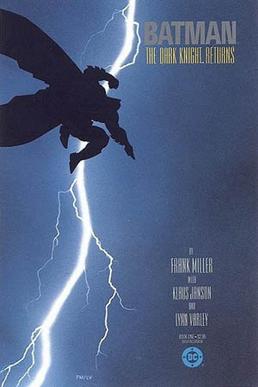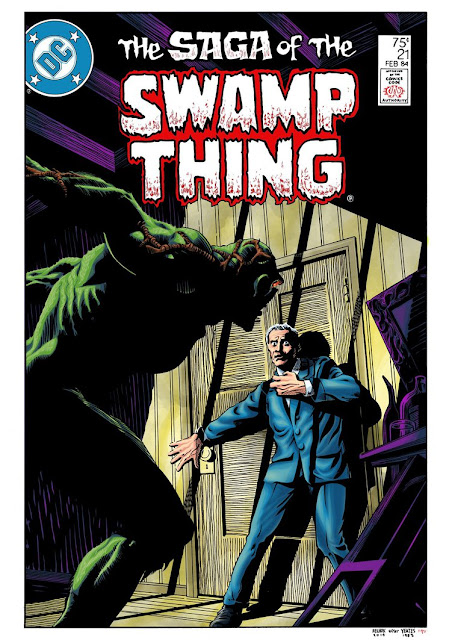A special thanks to
@Pyro and
@nick_crenshaw82 for the assist on the comics!
Part IV: Darkness Rising
From Pow! An Illustrated History of American Comics from the Victorian to the Modern
How and when do you define an “Age” of comics? Comics fans and industry experts continue to debate what defines an Age and when to mark it. And, of course, the Age most cite as the one that followed the Bronze Age is agreed to have begun in 1986, but damned if anyone can agree on when it ended or even if it ended! The editors of this tome can’t even agree, with most of us split between calling it the “Iron Age”, which seems the most technically accurate, and the “Dark Age”, which seems so on-the-nose for an antihero-dominated era marked by Superman going on a vengeance quest and the rise of Venom and Hellspawn. Others are pushing for “Steel Age”, “Copper Age”, or even insisting that the Modern Age began there and still hasn’t ended!
And we can only imagine what arguments will follow the defining of the Modern Age (we’re stumping for the “Aluminum Age”, since so much is “recycled”!).
The irony that the whole point of designating “Ages” is to give everyone a common point of reference is not lost on us.
Call the after-the-Bronze Age what you will, 1986 is seen in hindsight as its turning point, generally agreed to be marked by the watershed publishing of Alan Moore’s
Man of Steel and
Watchmen and Frank Miller’s
Batman: The Dark Knight series, and by the acquisition of Marvel by Disney and consolidation of DC by Warner Brothers.
Watchmen,
Man of Steel, and
The Dark Knight were watershed moments not for their darkness, but for their deconstructive nature. These were postmodern pieces that analyzed the very idea of the “superhero” and the masked vigilante, tore them into their component pieces, and looked at the logical ramifications of what they symbolized and how they would actually affect the world. These works were deep and philosophical explorations of the very central concept that drove the “superhero” and they changed the way that readers looked at the world of comics. The publishers, however, saw only the dark themes, antiheroic characters, and severe violence and misanthropy of the works, and said “yes, more of that, please.”
But even these watershed works did not appear out-of-the-blue. The rise of the Bronze Age in 1970 was made possible by the dwindling power of the Comics Code Authority, allowing for more mature and controversial subjects to be addressed, like politics, racism, sex, sexism, and substance abuse. It allowed for comics writers to explore the inner turmoil of their characters, now flawed men and women rather than the pillars of virtue seen in the Silver Age. Now Tony Stark could be an alcoholic or Green Arrow a political anarchist. In this regard, Marvel’s
X-Men might very well be the poster children, with their exploration of prejudice, flawed, bickering heroes, and sympathetic villains, e.g. Magneto being a Holocaust survivor who learned the wrong lessons from his trauma.
And indeed, the late ‘70s and early ‘80s show some tendencies towards darker, more antiheroic heroes, be that Wolverine or Green Arrow. Alan Moore had already given
Swamp Thing a tragic backstory and teamed with Kevin O’Neill on
Bizarro[1] long before he took some derived versions of the recently acquired Charlton Comics characters and built a dark, misanthropic alternate world where masked superheroes are mentally ill vigilantes and nuclear Armageddon seems inevitable, possibly welcome. As such, Miller’s return to Batman’s more gothic and brooding Golden Age roots wasn’t the titanic step it’s portrayed as in hindsight. Similarly, Moore’s deconstructive take in
Man of Steel, where a disassociated, semi-amnesiac Superman returns to Earth to find himself caught in a multidimensional flux where reality is "frozen" and flickering between two states (Pre- and Post-Crisis) and where he painfully confronts various “Imaginary Stories” versions of his Silver Age self[2], reflects the postmodern rethinking of superheroes that was happening in the early-to-mid ‘80s.
Similarly, the Disney acquisition wasn’t the random grab by the Mouse or cynical sellout by Stan Lee that it’s sometimes portrayed as in the fandom. Instead, the mid ‘80s were already a time of consolidation in the comics industry. DC had grabbed all of the most valuable IP from Charlton and Fawcett prior to the demise of the former and the selling of the latter. Attempts to integrate the lines into the existing canon increased the continuity snarl that was already locking out new readers, leading to the
Crisis on Infinite Earths storyline, Marv Wolfman’s “nuclear option” to cosmically reset the franchises, coincidentally just in time for Warner Brothers to rethink plans to sell off DC and instead acquire the film rights to Superman from the Salkind family.
Marvel pre-Disney also had its hands increasingly full attempting to juggle production of several of the Sunbow Toy Line animated series and the increasing company size as the Gold Key and Harvey lines and artists were integrated. The child-friendly Star line swelled, with Richie Rich now welcoming his noble British cousin and friendly rival Royal Roy to the family, allegedly created as a rip off of Richie when the Harvey deal looked ready to fall through. Baby Snoots, Pauline Peril, and the Little Monsters joined Mickey & Donald, the Muppet Babies, Waggle Rock, and The Ewaaks in the Star lineup. Casper was relaunched to much rejoicing. On the Marvel end, the Mighty Sampson joined forces with Killraven, Dagar joined the Hyborian Age with Conan, Tragg and the Sky Gods became Celestials, The Jungle Twins became allies to Wakanda, Turok entered the Savage Lands, and Dr. Spektor became a comrade to (and possibly a trans-dimensional doppelganger for) Dr. Strange, with his own Sanctum Sanctorum in San Francisco. Finally, in partnership with Sunbow and Hasbro, Marvel merged updated versions of M.A.R.S. Patrol Total War into GI Joe in a last-ditch attempt to save the flagging toy line and cartoon[3].
With so many moving parts and growing overhead, and with communications between the New York and LA offices strained, accepting a buyout offer was frankly just good business. Freed from the challenges of managing budgets and marketing, the creative artists could focus on the art, with new President Jim Shooter sensing the emerging zeitgeist and greatly expanding the scope and creative freedom for the Epic line. With Disney’s deep pockets there to pad the risk and Creative Chief Jim Henson’s “artistic freedom” mantra in his head, Shooter opened up the Epic line for “anything goes” levels of experimentation with tone, themes, and even artwork. Soon artists such as Todd McFarlane, Rob Liefeld, Marc Silvestri, Erik Larsen, Jim Valentino, Whilce Portacio, and Chris Claremont began to experiment with new characters and storylines, new mature subject matter, and even new technologies like digital comics made using modified Disney Imagination Stations.


DC soon followed suit with the creation of the mature Vertigo label, which would feature names like Neil Gaiman, Jamie Delano, and Garth Ennis, not to mention Alan Moore. Subjects like horror, religion, sex, homosexuality, drugs, graphic violence and the like became increasingly commonplace in the Epic and Vertigo lines, and were soon spilling over into the main DC and Marvel labels.
The Dark Age of Comics was truly born.
Or the Iron Age.
Or Steel. Or Copper.
Or Bakelite, whatever…
[1] Hat tip to
@nick_crenshaw82 for this butterfly; read details about this almost-happened comic
here.
[2] For those wanting to know Moore…err…more about this alternate
Man of Steel, here are some notes from
@Pyro, who suggested it:
[It] would take elements of his OTL run of Supreme and use them on the Man of Steel mini-series and possibly directly reference the Crisis where the a semi-amnesiac Superman returns to Earth to find himself caught up in sort of flux where reality is "frozen" and flickering between two states (Pre-Crisis and Post-Crisis.) There he encounters several alternate versions of the Man of Steel from the old Silver Age "Imaginary Stories" that take him to a place called the Supremacy where all "retired" versions of the Man of Steel and his supporting go after each "revision" to reality.
It's there where the Earth-Two (Golden Age) Superman and Lois Lane, Earth-Prime Superboy, and Alexander Luthor went to in Crisis on Infinite Earths #12 and where the "new" Superman learns of "Revision Theory." This theory posits that the arrival of Superman either created a ripple in reality that caused it to continually revise itself, or that reality has always been shifting and the Supermen were the among the few beings that can perceive it. In either case, the Supermen give the new incarnation a sendoff to start his existence and walks through the gateway back to reality where he finds himself at the offices of the Daily Planet.
As for some notable "revisions" to reality:
-Lois Lane's personality has changed to a driven, career-focused woman who doesn't fawn over Superman and views Clark Kent as more of a rival than display any romantic interest. At first, anyway.
-Lex Luthor is CEO of LexCorp like OTL to better reflect the times where a cutthroat capitalist is more believable than a mad scientist in the "Greed is good" eighties. This was actually an idea of Marv Wolfman, who was writing the Adventures of Superman title at the time.
-Jonathan and Martha Kent are still alive.
-Superman is the sole survivor of Krypton so there is no Kara Zor-El is this revision, no do Krypto the Bottle City of Kandor. This was a mandate by then-DC president, Jeanette Khan. However, a non-Kryptonian Supergirl is a possibility.
-Clark Kent officially "began" his career as Superman, however, Alan Moore saw the continuity error since the non-rebooted Legion of Super-Heroes still had Superboy as a member and insisted that part of Superman's history remained intact. A compromise would be worked out that Clark Kent was active in the 30th century as Superboy for a time before the Legion erased his memory of his time there on his last official mission to preserve the integrity of the timeline.
[3] These butterflies (with some modification by me) suggested by
@nick_crenshaw82.






